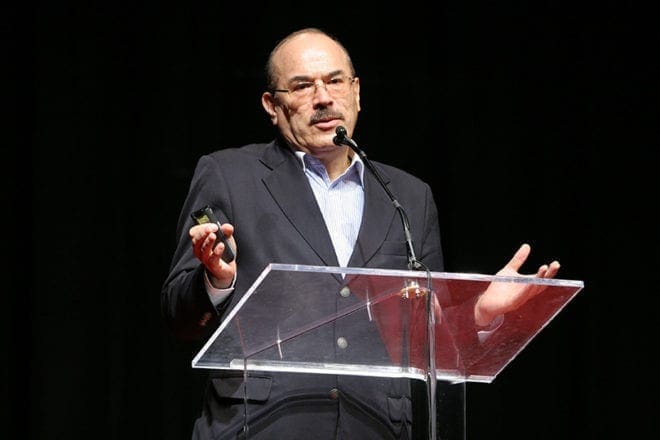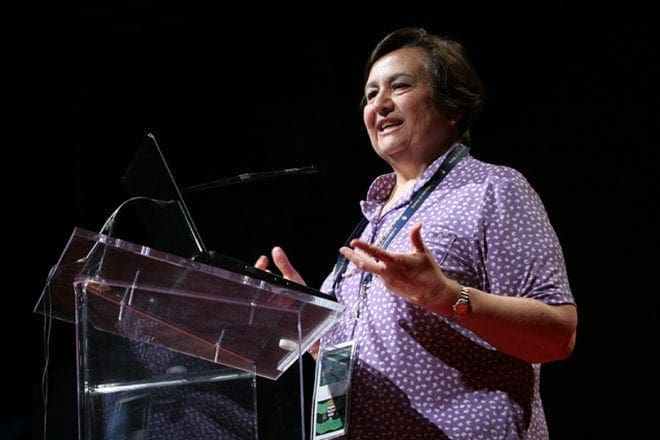 Photo By Michael Alexander
Photo By Michael AlexanderCollege Park
Hispanics Challenged To Pass Faith To Their Children
By RUTH E. DÁVILA, Special To The Bulletin | Published June 10, 2010
When Atlanta’s Auxiliary Bishop Luis Zarama greeted thousands of Spanish-speaking attendees at the Eucharistic Congress’ Hispanic track June 5, section by section people rose to their feet. Whistles, applause and shouts of “bravo” resounded through Exhibit Hall B of the Georgia International Convention Center.
“Seeing the procession today, the people’s faces … it’s really energizing,” Bishop Zarama said from the podium.
As the first speaker of the Hispanic session, Bishop Zarama launched his talk by posing a question: “How has the Lord accompanied us in the history of humanity?”
He answered this question by citing a series of humble, unlikely individuals chosen to do God’s work—from King David to the Virgin Mary.
“And, in what way has God chosen to remain with us?” he later asked. “The Eucharist,” he concluded, setting the tone for the day’s agenda.
The bishop’s primary message: “Discover beauty in simplicity.”
Human beings, in their simplicity, represent the ultimate expression of God’s love. Bishop Zarama pointed out that the Lord was personally and intimately involved in the creation of humanity. He said, “Let there be,” and the stars were made, but he said, “Let us make man.”
“Our weaknesses are God’s strength,” Bishop Zarama said, “because it is through these that God is revealed.”
Toward his conclusion, overcome by emotion, he opened up to the faithful.
“You all are,” he began, trailing off and holding back tears. Unable to find an adjective to describe the community, he raised both hands, pointing two thumbs up in approbation, and once again the audience roared with applause.
Bishop Zarama’s affection struck a chord with those in attendance. Arnulfo Anaya, a physician from Mexico who attends St. Thomas the Apostle in Smyrna, has participated in the Congress five consecutive years. He said that Bishop Zarama gave a warm welcome last year, but that now, since being ordained bishop in September 2009, his emotion was even stronger.
“Today (Bishop Zarama) expressed a simpler feeling, more humble and more in tune with the people,” said Anaya.
The aim for humility resonated with the Congress’ theme: to sanctify the Christian people.
Future Of The Church
Carmen Maria Cervantes, executive director of the California-based Instituto Fe y Vida (Institute for Faith and Life), was second on the roster. Her organization empowers young Hispanics to become leaders in the church and society.
Reaching out to parents, Cervantes spoke in an urgent tone about the reality of the Catholic Church today. Hispanics represent the future, in numbers alone, but the community faces peril if youths are not guided through Catholic formation.
“The majority of children born here (in the United States), if they don’t become active in church, will lose their religion altogether,” she said, pointing to a chart that illustrated the trend.
It is up to parents to lead their children by example.
“How do we allow ourselves to be sacrificed for Christ?” Cervantes asked. The key is to “carry the Eucharist to all dimensions of our lives,” she said.

Dr. Ricardo Castañón-Gómez, president and researcher of Grupo Internacional para la Paz, speaks in the Hispanic Track. Photo By Michael Alexander
It is important to examine oneself and one’s own culture—weeding out traditions that oppose one’s faith and replacing them with new ones that support it.
“We have to be Christ in our own environments,” Cervantes said. “Sanctifying ourselves is not just about prayer and direct communion with God; it’s about our entire surroundings.”
Cervantes said one way to transmit good values is to steer children toward the Bible. Her organization supports BibliaParaJovenes.org, the first mission in the Americas to teach the Catholic Bible to young people in Spanish.
A living testimony to the power of youth, in between each talk, Emmanuel, a local Hispanic youth choir, entertained throngs of enthusiastic Spanish speakers. At the event’s closing, Juan Diaz, master of ceremonies and host of “Nuestra Fe” on 610 AM, called to the young people to form a train around the auditorium. To Emmanuel’s songs of praise, punctuated by conga beats, a winding line of attendees danced through the aisles with outstretched arms.
Body And Blood
“The music was phenomenal at the Hispanic session,” Alex Torres, 24, commented after the program. He used to play guitar in his native El Salvador and has since taken up bass at St. Andrew Church in Roswell. “It was upbeat, joyful—music that seeks to lift people’s spirits.”
Torres has a problem that many Catholics face. He and his girlfriend, who is expecting a baby, cannot receive Communion because they are not married in the Church.
“The most important thing for us is to seek God’s grace. On one occasion, I even cried because of the separation from the Eucharist,” he confided, adding that he hopes to have a church wedding this year.
The third speaker, Ricardo Castañón Gómez, gave a palpable reminder to Torres of what he is missing: the Real Presence of Christ in the Eucharist.
Castañón Gómez is president of the Grupo Internacional Para la Paz (International Group for Peace). Based in Bolivia, Castañón Gómez’s home country, and also operating out of the other members’ 12 countries, the nonprofit group is a collection of self-financed research professionals who investigate mystical phenomena. They report their results, as scientific opinion, directly to the Vatican for consideration.
Castañón Gómez, a clinical psychologist specializing in brain biochemistry, has participated in more than half a dozen studies of Eucharistic miracles over the past two decades.
During the first half of his talk, Castañón Gómez broke down how humans process experiences on a neurological level.
He explained, with graphical aids, the firing of neurotransmitters that occurs during thoughts and reactions and how these lead to habits.
“The imprint that is left after you say something hurtful to someone is larger than the imprint of forgiveness,” he said.
The genius of the human mind, he pointed out, is that cerebral imprints can change. Where an alcoholic once had an imprint of excess drinking, after making a commitment to sobriety, he can fill the imprint with healthy behaviors, such as a workout routine and other wellness activities.
All of these insights are important because gaining an understanding of human nature enables Catholics to better live the faith, he said.
“In the modern world today, there is an opposition between science and faith,” Castañón Gómez said in an interview after the Congress. He aimed to bridge this divide in his presentation.
During his talk, he highlighted some of the investigations of Eucharistic miracles that he has overseen. (Catholics believe that the consecrated host is the Body, Blood, Soul and Divinity of Jesus, under the appearances of bread and wine. Eucharistic miracles are rare events where a consecrated host has turned into human flesh and blood, according to a recent Vatican document on the topic.) He spoke of a case at Santa Maria Church in Buenos Aires, Argentina.
From 1999 to 2004, Castañón Gómez ordered a series of tests on samples taken from the Eucharist by independent scientists who were not told of the samples’ origin. A forensic pathologist, Frederick Zugibe, concluded that the sample he had tested was a piece of human heart—specifically from the left ventricle of the myocardium. In addition, the sample was found to contain white and red blood cells.
Flocks of faithful—in colored T-shirts according to parish affiliation—sat in awe while Castañón Gómez reviewed these findings. Patricia Madriz accompanied a group of yellow-shirted parishioners from Our Lady of Perpetual Help Church in Carrollton.
Madriz has visited the adoration room for the six years that she has attended the Congress. But Castañón Gómez’s presentation brought a richer meaning to her experience this time.
“Adoration felt more fulfilling this year,” Madriz said. “My faith was strengthened on a physical level. I felt it on a spiritual level before, but now I had physical, scientific proof.”
Love And Communion
Archbishop J. Michael Miller, of the Archdiocese of Vancouver, Canada, wrapped up the session, circling back to the matter of sanctification. He described sainthood as a call for all faithful.
“Sainthood is the only thing necessary for the believer,” Archbishop Miller said. “If we don’t have that, we fail.”
Christ is the only one who makes us saintly, he continued, and priests are the manifest instrument of Christ.
“In the Church, the priest does not act on behalf of an absent person, but rather Christ acts through the priest by his reception of the sacrament (of ordination),” Archbishop Miller said.
The heart of the priesthood is the Eucharist, added Archbishop Miller, who is vice president of the Pontifical Work of Priestly Vocations for the Pontifical Committee for International Eucharistic Congresses.

Dr. Carmen Cervantes, executive director of Instituto Fe y Vida, was one of two lay presenters in the Hispanic Track. Fe y Vida promotes the development of leaders in the Catholic Church who can “respond to the human, spiritual, and socio-cultural needs of Hispanic youth and young adults.” Photo By Michael Alexander
The miracle that occurs when a priest says the words of consecration over the bread and wine is the center of Catholic existence. The real presence of Jesus in the Eucharist brings us into communion with God’s compassion, and that starts a cycle of love for all who are open to receive it.
“In the people I encounter, I recognize brothers and sisters,” Archbishop Miller said.
Patricia Madriz shares this sentiment. She calls the Hispanic community of her parish her “family.” She arrived at the Congress with two busloads of parishioners from Carrollton, most of whom are Hispanic.
Seventeen years ago, when Madriz came to this country from Nicaragua with her husband and four children, she and her spouse each worked two jobs to make ends meet. It wasn’t until after moving to the Atlanta area from Philadelphia that she became the parish secretary and began to deepen her faith.
Though Madriz holds a degree in electrical engineering from her birth country, she started out working at a gas station in the United States and has never practiced her profession. Still, she says, feeling close to Christ in events like the Congress is the most rewarding aspect of her life.
“In this world, you don’t really need money—what you need is God,” she said. “That energy is what really moves us.”